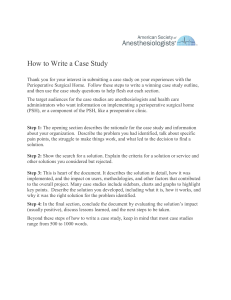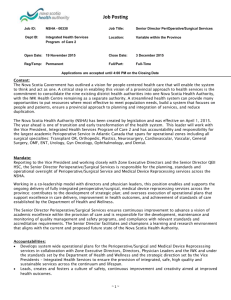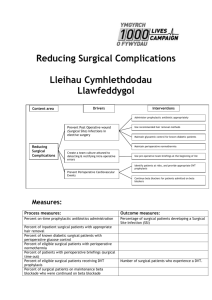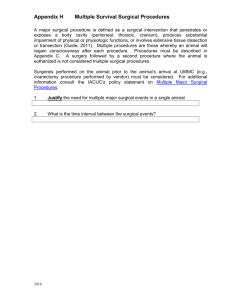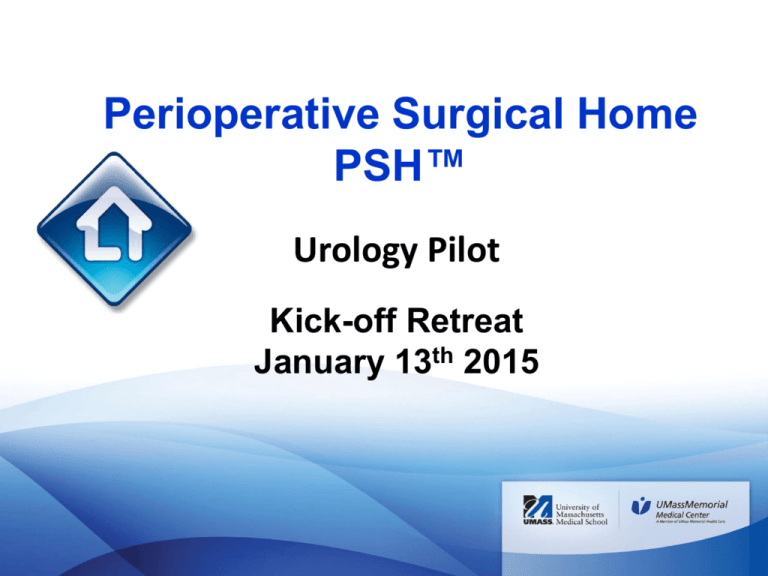
Perioperative Surgical Home
PSH™
Urology Pilot
Kick-off Retreat
January 13th 2015
Welcome
Dr. Judith Steinberg, MD, MPH
Deputy Chief Medical Officer
Commonwealth Medicine
University of Massachusetts Medical School
|
|
Retreat Objectives
• Present rationale for Perioperative Surgical Home
(PSH) and its alignment with University of
Massachusetts Memorial Medical Center (UMMMC)
2020 Vision and Strategic Plan
• Discuss Perioperative Surgical Home Pilot: Patients,
Teams, Process for Change and Outcomes
• Identify next steps and timeline for implementation
of Perioperative Surgical Home Pilot
|
|
Agenda
Start 1:00 PM
• Welcome
• Why Perioperative Surgical Home Pilot
• Alignment with UMMMC Vision/Strategy
• Overview of Pilot
• Team Breakout Sessions
• Report on Breakout Sessions
• Timeline and Next Steps
End 5:00PM
|
|
“I Have a Dream”
|
|
Why PSH™
Shubjeet Kaur, MD M.Sc.HCM
Professor and Executive Vice Chair of Anesthesiology
University of Massachusetts Medical School
UMass Memorial Medical Center
|
|
Unsustainable : Projected
Health Care Spending as % GDP
National and Surgical Health Care
Expenditure
2 Trillion
Munoz et al
Ann Surg. Feb
2010
|
60%
|
Institute of Medicine
Three Landmark Reports
The First
1999
To Err is Human
98,000 patients die each year as a result of
preventable medical error
Institute of Medicine
Three Landmark Reports
The Second
2001
Crossing the Quality Chasm: A New
Health System for the 21st Century
Call for Action
Closing the Quality Gap- Volume to Value
Institute of Medicine
Three Landmark Reports
The Third
2012
The Health Care Imperative: Lowering
Cost and Improving Outcomes
WASTE
Eliminate Waste=Control Cost
IOM Report:
|
|
Waste Identified in IOM Report
High
Pricing
Adm
Expenses
Missed
Prevention
Opportunities
Waste Identified in IOM Report
Fraud
Unneeded
Services
Inefficient
Delivery of
Services
IOM Report 2012
Improved
Delivery of
Service
|
|
Savings
130 Billion
Complex Process
Decision
Surgery
Pre-op
Postop
Intra-op
Discharge
|
|
Variation
|
|
Atul Gawande
“Our Struggle is with….complexity…how much
you have to …have in your head…There are a
thousand ways things can go wrong.
We are inconsistent and unreliable
because of the complexity of care
|
|
TIME for CHANGE
|
|
CHANGE
VOLUME
|
|
VALUE
Porter’s Value Paradigm As Applied To
Health Care
VALUE
OUTCOMES
M. Porter
NEJM 363;26
2010
|
|
Patient
Experience
Perspective
COST
PSH™- A Link
Improve
Quality
Value
Patient
Experience
Decrease
Waste
THE PARALLEL
PATIENT CENTERED MEDICAL
HOME
|
|
Patient Centered Primary Care
Collaborative
Grundy et al
Cost and Quality
Review 2012
|
|
Cost and Quality Report 2012
PCMH
IMPROVES OUTCOMES
ENHANCES PATIENT EXPERIENCE
DECREASES HOSPITAL AND ER UTILZATION
|
|
THE PRECEDENT
CRITICAL CARE
ANESTHESIOLOGY
|
|
Evolution of Critical Care
1970s
1980s
NOW
Resistance from
Surgeons
Anesthesia
Critical Care
Fellowships
Leaders in
Critical Care
Open Units
Payment
Reform
Concerns about
Reimbursement
|
|
Closed Units
PROPONENT
Personal Interest
Panel Discussion ASA 2012 Annual Conference
ASA
Trademarked Name: Perioperative Surgical
Home™
Established Committee to Lead the Work
ASA Committee for Future Models of Anesthesia
Practice- 2012
|
|
Perioperative Surgical Home™
Model Brief
American Society of Anesthesiologists
All Rights Reserved
Issued by ASA CFMAP August 2013
Request for Funding
Multicenter National Learning
Collaborative
Started July 2014
|
|
PILLARS
Coordinated
Care
|
Team
Based
|
Patient
Satisfaction
Improved
Outcomes
Lower Cost
Core Principle of PSH™
Respect
Patient
Providers
Process
|
|
Perioperative Surgical Home (PSH)
• The PSH is a patient-centered, physician-led
multidisciplinary, and team-based system of coordinated
care for the surgical patient.
– The PSH spans the entire surgical experience from decision for
the need for surgery to discharge from a medical facility and
beyond.
– The goal of the PSH is to enhance value and help achieve the
Triple Aim: a better patient experience, better health care, and a
lower cost.
• "The aggregate benefits to the specialty and to patient
care will be substantial and game-changing, even if a
minority of anesthesia groups are in a PSH in the first
few years."
Perioperative Surgical Home
|
|
9/29/2013
How Would This Work?
PCMH
Discharge
Planning
Post-op
Care
|
PSH™
Shared
Decision
Making
|
Patient
Safe &
Satisfied
Coordinate
Care
Intraop Care
Connection between PCMH and PSH
|
|
8/7/2013
PSH How is it Different?
Perioperative Surgical Home
|
|
8/7/2013
Current vs. Perioperative Surgical Home
Patient has a problem – Is there a surgical solution?
Perioperative Surgical
Home
Business as usual
• Avoidable readmissions
• Avoidable complications
• Unsubstantiated variation
• Current costs continue
• Current patient experience
• Current return to work
|
|
9/29/13
• Minimized readmissions
• Minimized complications
• Evidence based care
or
• Costs decreased
• ↑ satisfaction / ↓ suffering
• Increased productivity
How PSH Aligns with Triple Aim
|
|
•
Early and continued patient engagement
•
Optimal pre-op testing and preparation
•
Intraoperative efficiency
•
Improved patient satisfaction
•
Improved clinical outcomes and fewer
complications
•
Application of evidence-based principles
•
Lower cost for Physician Preference Items
•
Post-procedural care initiatives
•
Care coordination and transition planning
Perioperative
Surgical Home
9/29/13
PSH and Accountable Care:
Two Sides of the Same Coin
Accountable Care
Hospitals
PSH
PCMH
PCP
Patient
PCMH
Care Coordination
Specialists
PCP
Public Health
PCMH
Health IT Infrastructure
Perioperative Surgical Home
9/29/2013
Future Payment Model approaches
•
•
•
•
•
•
Bundled Payments
Shared Savings
“S” Code for Management fee
Co-management
Risk Sharing / ACO
Capitation / ACO
|
|
Perioperative
Surgical Home
11/10/13
Alignment with our Health
Sciences System
LEAN Transformation
ACO 2015
Focus on Transitions of Care
|
|
Best Place To Give Care – Best Place to Get Care
42
UMMHC 2020 Vision
We will become the best academic health system in New England based on measures of
patient safety, quality, cost, patient satisfaction, innovation, education and caregiver
engagement.
43
HOW TO OPEN THE VALVES?
44
Create a Shared Vision
and Common Direction
|
|
TEAM
WORK
SUCCESS
RESPECT
|
|
Peri-operative Surgical Home
Why Urology?
Mitchell H. Sokoloff, M.D., F.A.C.S.
Professor and Chair, Department of Urology
University of Massachusetts Medical School
UMass-Memorial Health Care
Department of Urology
“Embracing and advancing
innovation in urologic care,
research, and education.”
— Mission Statement 2014
|
|
Urology Reinvention
•
In the process of creating a new department and
establishing a new departmental culture
•
Overarching vision: “To become a leader in
establishing policy and practice in urologic care by
2020”
|
|
Urology Reinvention
•
Welcome the opportunity to provide innovative
state-of-the art, patient-focused, and costconscious approaches to surgical care
•
Melds well with national initiatives, including
those of the AUA (American Urological
Association)”
|
|
Why UM/UMMHC Urology?
•
Aligned with PSH philosophy
•
Adult practice is almost completely limited to a
single campus (Memorial)
•
History of collaboration in in-patient care given
lack of residents
•
Supports other initiatives underway with
objective of improving OR and in-patient care at
Memorial campus
|
|
Urologic/Oncology Focus
•
The pilot will start with urologic oncology
o most
complicated and involved cases
o forefront
of innovation with regards to
comprehensive, team-based, patientcentered, coordinated care focused on
cost-containment
•
|
More details to follow with regard to specific
cases and faculty
|
Urology
Treating for today, teaching for
tomorrow, innovating for the future
|
|
Why the Anesthesiology CCM Team
at Memorial Campus
Khaldoun Faris, MD
Clinical Associate Professor, Anesthesiology and Surgery
Medical Director, SICU
Nothing endures but change
Heraclitus of Ephesus 600 BCE
Experience
• In peri-operative medicine
• CCM, surgical and medical patients
• Pain management
• Preoperative medicine
• In team playing
• Multidisciplinary teams in the ICUs
• CCOC
• e ICU
• In change
• CCOC
• Department
|
|
Staff
• Eight anesthesiologist intensivists
•
•
•
•
Four
Three
Three
Eight
PSE
Memorial OR
Acute pain service
SICU
• Provide continuum of care
• PCP - PSE – SACU – OR – PACU – ICU –
floor – discharge – post discharge – PCP
|
|
Location
Memorial SICU
• Ideal size, 9 beds
• Similar to UAB PSH location
• Allows for covering 2-5 floor patients
• Almost 100 % covered by Anesthesiology
CCM team
• Home of Dept. of Urology
• Home of the critically ill urology patients
|
|
Collaboration
• Our specialty only works in the environment of
collaboration
• UMass leadership supports collaboration
• New leadership in Urology embraces
collaboration
• The more collaboration the better the outcome
|
|
Embracing Change
• Nothing endures but change
• Economical forces, less resources
• Political forces, expanding coverage and improving
outcome
• Patient forces, better outcome and more
satisfaction
• Future models of practice
• PSH equals affordable care
|
|
Conclusion
• Our goal is a patient
centered care, that is
efficient, safe, and of
the highest quality
• PSH is the model to
achieve this goal
• The society and the
patients are watching
• And listening
Dr. Stephen Tosi MD
Chief Physician Executive, UMMHC
President, UMass Memorial Medical Group
|
|
Peri-operative Surgical Home Pilot
Patients and Teams
Mitchell H. Sokoloff, M.D., F.A.C.S.
Professor and Chair, Department of Urology
Khaldoun Faris, MD
Clinical Associate Professor, Anesthesiology
and Surgery & Medical Director, SICU
Objectives
•
Coordinated, comprehensive, team-based, and
patient-centered
•
Provide seamless transitions of care with focus
on standardization, cost effectiveness, and
quality and safety
|
|
Which Faculty?
•
Initially: Drs. Sokoloff, Yates, and Berry
•
Expand to: Drs. Steiger, Bamberger and
Bernhard (depending on volume of cases)
|
|
Patients
• Complex urology patients
• Mostly cancer patient
• Require admission to the hospital
• Not necessarily to the ICU
• The urology/anesthesiology CCM teams will
follow the patients from the time of PCP referral
to the time of return to PCP
• PCP - PSE – SACU – OR – PACU – ICU –
floor – discharge – post discharge – PCP
|
|
Which Patients?
•
Radical Prostatectomy (open and robotic)
•
Radical Nephrectomy (open, lap, and robotic)
•
Partial Nephrectomy (open, lap, and robotic)
•
Radical Cystectomy (open and robotic)
•
Retroperitoneal LN Dissection (RPLND: open)
•
Specific faculty: Drs. Sokoloff, Yates, and Berry
|
|
Pilot Approach: Teams
• Five different teams
o Preoperative team
o Intraoperative team
o Postoperative team
o Post discharge team
o Quality and safety team
• Team leads and members: physicians, affiliate
physicians, nurses, managers, other
stakeholders
|
|
Team Responsibility
• Identify roles and responsibilities of members
• Evaluate the current practice and recommends
the changes needed to achieve the ideal
practice
• Review process and outcome measures and
ways to collect the data
• ASA Newsletter 10/2014
|
|
Measures
•
•
•
•
•
Clinical process measures
Efficiency process measures
Safety outcome measures
Economic outcome measures
Patient-centered outcome measures
American Society of Anesthesiologists Article October 1, 2014 Volume 78, Number 10
The PSH: Clinical Safety, Internal Efficiency, and Economic and Patient-Centered Metrics Howard A.
Schwid, M.D. Zeev N. Kain, M.D., M.B.A. Richard P. Dutton, M.D., M.B.A
|
|
Measurable Outcomes
•
Efficiency (resources, staffing, supplies, equipment)
•
Decrease in cost
•
Decrease in hospital stay, increase in recovery
•
Decrease in complications and readmissions
•
Increase in physician and staff satisfaction
•
Increased coordination and communication
•
Increase in patient satisfaction
•
Increase quality of care
|
|
Department of Urology
“Embracing and advancing
innovation in urologic care,
research, and education.”
— Mission Statement 2014
|
|
Governance of the Pilot
Committee
Meeting Frequency
Project Team Leadership
Every other week
Teams
Weekly
All Team Meeting
Monthly
Steering Committee (multi-stakeholder)
Quarterly
Shared Learning
Project Team Leadership: Drs. Kaur, Sokoloff, Faris, Steinberg, CWM
consultants, & Team Leads
|
|
Team Break-Out Sessions
•
Introduce Teams
•
Team Discussion: Each team to:
o
Review and modify suggested process changes
What is current process?
What is ideal future state?
o What
do we need to operationalize new
protocol/roles and responsibilities of team members?
o Review
|
outcomes for each process
|
Teams
Intra-Op Team
Pre-Op Team
Post-Op Team
Leads: Mitchell Sokkoloff, Maksim
Zayaruzny, Joann Geslak
Leads: Theofilis Matheos, Alexander
Berry
Leads: Jennifer Yates, Khaldoun Faris
Gus Angaramo
Antonio Aponte
Suzanne Ashton
Kathleen Barber
Jane Baron
Pamela Benton
Alok Kapoor
Pam Haggerty
Melinda Miville
John Jepson
Barbara Steadman
Pat Kusz
Lauren Bersey
Wendy Hodgerney
Johhny Isenberger
Jenna L’Herueux
Erin Legier
Christopher St. Amand
Michael Puim
Devein Walmsley
Quality and Safety Outcomes
Leads: Shubjeet Kaur, Stephen Heard,
Mitchell Sokoloff
Post Discharge Team
Jerone Allison
Shrayn DeMango
Leads: Manilo Grant, Tess Gessler
Khaldoun Faris,
Deborah Caneen
Ellen Felkel-Brennan
Christine Coulomobe
Alok Kapoor
Craig Lilly
Mary Naples
Maija Sumner
Lori Pelletier
Lauren Russell
Matthias Walz
Kathleen Whyte
|
|
Central Tenets of Perioperative Surgical
Home
• Patient and family centeredness and shared
decision making
• Evidence-based care
• Standard Work
• Attention to quality and safety
• Coordination and communication across
perioperative care and medical neighborhood
|
|
Joint Replacement PSH - UCI
|
|
Timeline for the Perioperative Surgical
Home Pilot
• January 13, 2015 - March 1, 2015: Teams
meet weekly to hone their processes
• Week of March 30, 2015: Implementation
kick-off meeting
• March 30, 2015 - Official launch date of PSH
pilot
• March 30, 2016 - End of PSH pilot
|
|
Governance of the Pilot
Committee
Meeting Frequency
Project Team Leadership
Every other week
Teams
Weekly
All Team Meeting
Monthly
Steering Committee (multi-stakeholder)
Quarterly
Shared Learning
Project Team Leadership: Drs. Kaur, Sokoloff, Faris, Steinberg, CWM
consultants, & Team Leads
|
|

